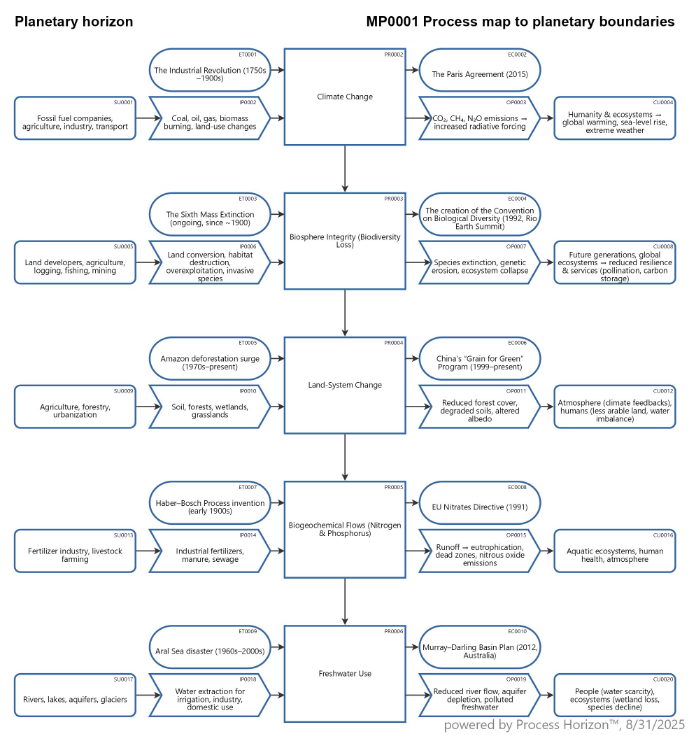Process map to Planetary Boundaries (1 to 5)

The planetary limits sometimes called planetary boundaries are a scientific framework introduced in 2009 (and updated in 2015 and 2023) by Johan Rockström, Will Steffen, and colleagues. They identify the safe operating space for humanity on Earth, beyond which the stability and resilience of the Earth system could be at risk. There are nine original boundaries, with a tenth often included in expanded discussions.
If we think of the planetary boundaries as a process map, what would the SIPOC (Suppliers → Inputs → Process → Outputs → Customers) look like ?
- Climate Change Process Energy production, industrial activity, land clearing: greenhouse gas concentrations & radiative forcing that regulate global temperature and climate stability
- Biosphere Integrity Process Expansion of human footprint, resource extraction: Biodiversity loss, i.e. genetic diversity & ecosystem function, split into genetic diversity (species extinctions) & functional diversity (ecosystem roles)
- Land-System Change Process Deforestation, monoculture cropping, urban sprawl: deforestation, land-use conversion & agricultural expansion
- Biogeochemical Flows Process Over-application in agriculture, poor waste management: disruption of nitrogen and phosphorus cycles due to fertilizers & pollution
- Freshwater Use Process Distribution, consumption, pollution: availability & consumption of surface and groundwater
- Ocean Acidification Process Chemical dissolution → carbonic acid formation: caused by absorption of CO₂, altering marine ecosystems
- Atmospheric Aerosol Loading Process Emission, atmospheric accumulation: particulate pollution affecting climate & human health
- Stratospheric Ozone Depletion Process Release, transport to stratosphere, ozone breakdown: ozone layer thinning due to CFCs & other chemicals
- Novel Entities (Chemical Pollution) Process Production, use, disposal: synthetic compounds, plastics, microplastics, heavy metals, radioactive waste
- Functional Integrity of the Biosphere Process Pollination, nutrient cycling, water purification: sometimes separated from biodiversity, it refers to maintaining ecosystem services like pollination, water purification & soil fertility
What major events (either positive or negative) significantly affect or could affect each planetary boundary are reflected as trigger events.
- Most negative events are linked to industrialization, fossil fuels & large-scale agriculture
- Most positive events are policy-driven global agreements or local conservation successes
Scientists say that six of these nine boundaries have already been transgressed: climate change, biosphere integrity, land-system change, biogeochemical flows (nitrogen & phosphorus), freshwater change and novel entities.
Using the following link you can access this sandbox SIPOC model in the ProcessHorizon web app and adapt it to your needs (easy customizing) and export or print the automagically created visual AllinOne SIPOC map as a PDF document or share it with your peers: https://app.processhorizon.com/enterprises/dmFgeiFoommV8MjCDyC3ynUi/frontend

